Useful References:
Crossroads Guitar Lessons, Tabs & Chords
Crossroads online guitar tabs and guitar lessons conducts streaming instruction for advanced or beginning guitar students; try our free lessons before you purchase!
A guitar chord chart displays the notes in a chord by associating them with finger positions on the guitar neck. The index finger is numbered 1 through to the little finger which is numbered 4. The thumb is denoted T.
Sometimes fingering, as such are not given at all. The chord chart may be no more than a series of dots on a grid showing where strings are stopped and where strings are open, i.e. unstopped. Unstopped strings may be marked with an X or an O above the chart.
We have imported links to Phillip J. Facoline's Ultimate Guitar Chord Chart Web Page
Click on the page number below to view the respective page of the chord chart.
1 | 2 | 3 | 4 | 5 | 6 | 7 | 8 | 9 | 10 | 11 | 12 | 13 | 14
Click here to view the chord chart in PDF format.
Click hereto download the chord chart in Postscript format.
While most guitarists will and can read from standard musical notation, others may more commonly use tablature, a notational system that describes how the fingers are placed on the strings and frets of the instrument. This was common notation for lute music.
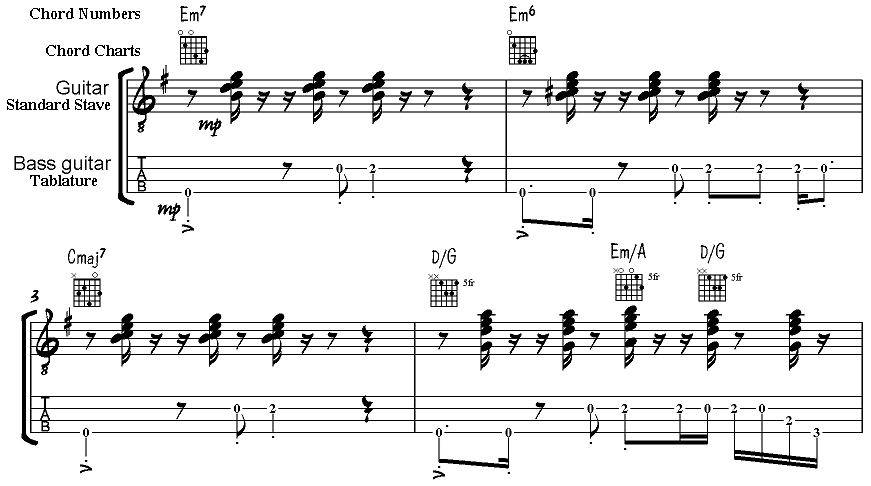
On the upper 'Guitar' line you will see a combination of standard notation, chord numbers and chord charts, while the lower 'Bass Guitar' line is set out in tablature form. Here, on the lower line, the tail/flag combination tells us the note's time-value and the line and the number on it tells us on which string (line) and fret (number) the player's finger should be placed. Chords notated in tablature will be a vertical column of numbers (fret positions) one on each line (string).
The Origins of Tablature Notation
::

Tablature (as it applies to lutes and viols) shows locations rather than specific pitches. It allows retuning of the instrument (scordatura), and makes reading chords much simpler. While it is possible to transcribe tablature into staff notation, the music usually makes much less sense, and may be much more difficult to read, especially when using a non-standard tuning. But there is a vast amount of music in tablature, and it is well worth the effort to learn it.
We have taken the following extract from Reading Lute Tablature by Conrad Leviston.
|
In standard lute tablature, each stave has six lines, representing the six courses of a lute. A course is a group of strings tuned to the same note. The course of highest pitch appears at the top, and that of lowest appears at the bottom, hence:
On each of these lines are placed letters to represent notes. If you are required to play an open D string, for instance, a small "a" will be placed on the appropriate line. For a note with the finger on the first fret, a "b", a note on the second fret, a "c", etc. The only exception to this is that no "j" is used, as it was considered to be more or less the same as "i". So:
would represent a Gm chord, and in normal guitar tuning would be an E chord. If a seventh course were used its symbol would appear below the sixth (funny that). If an eighth were used, it would appear in the same place, but with a line above it. Similarly a ninth course note would have two lines above it. The only other thing to be said about this notation is that the symbol # does not mean sharp. It does in fact represent a trill. The exact form of the trill is not known, but it did appear to have a specific meaning. Generally, one just trills from the note in the scale above the note in question. Timing is fairly straight forward. A semi-breve is represented by a stick, with a tail pointing to the left (/|), a minim by a simple stick (|), a crotchet by a stick with a tail pointing to the right (|\), a quaver by a stick with two tails pointing to the right, and so on. The duration of a note is determined by the time indicator above it. If there is no time indicator above a note, its duration is equal to that of the last note. For notes that last one and a half times as long as normal, a dot is added to the side of the time indicator, as in normal sheet music. There are two major variations of this form of tablature. Firstly, letters being replaced by numbers. This leads to the system used in modern guitar tablature, and has the elegant advantage of "0" representing an open fret. Secondly, the tablature may be written upside down. This system is more logical, in that you are essentially looking at the mirror image of your instrument. Unfortunately, for whatever reason, I do not find it as natural to play. Different areas used different notations at different times, but in general, the French and English used the above system (often refered to as French tablature), the Italians used the above system, with the second change, and the Spanish used both changes. German Tablature is completely different all together. German tablature although more difficult to read, was nonetheless popular owing to its efficient use of paper. Here are set out instructions for reading this tablature. Once you have acquired the knowledge required to interpret it, however, I suggest you use it to translate it into a more palatable form, such as French, as it is not simple to read off quickly. German tablature was designed by Conrad Paumann (1410-73) for a lute of five courses. Conrad Paumann was a German organist, blind from birth. In 1440 he became an organist in his native city, and in 1451 entered the service of the Dukes of Bavaria. As a performer on many instruments he won great renown, which became international with a visit to the Mantua court in 1470; both the Duke of Milan and the King of Aragon desired his services but he declined, fearing reprisals by competing Italian organists. His compositions include a few songs and organ pieces, and a treatise of 1452 (Fundamentum organisandi) copied into the last pages of the Locheimer Liederbuch. This elucidates the embellishment of chant in keyboard style, and contains sensitive arrangements of chants and secular melodies. When six courses became more common on the lute the tablature was adapted to make it possible to indicate notes on the extra string. This is not an ideal system, as will be seen later. The system starts by giving the values 1, 2, 3, 4 and 5 to the open strings, with lowest toned string (usually C) being 1. The strings first frets are given the values a, b, c, d and e in the same manner as before. The strings second frets are given the values f, g, h, i and k (i and j are deemed too similar in most alphabet based tablatures). Following this method (with a German alphabet), we end up with:
5 |--e--|--k--|--p--|--v--|--9--|- G | | | | | | 4 |--d--|--i--|--o--|--t--|--7--|- D | | | | | | 3 |--c--|--h--|--n--|--s--|--z--|- A | | | | | | 2 |--b--|--g--|--m--|--r--|--y--|- F | | | | | | 1 |--a--|--f--|--l--|--q--|--x--|- C Note the presence of 7 and 9. These are the most common characters for these positions, but by no means universal. They are often referred to as "et" and "con". Beyond the fifth fret, the lettering sequence is repeated, however, to distinguish these letters from those before, a bar is added above, hence:
_ _ _ _
5 |--e--|--k--|--p--|--v--|--9--|--e--|--k--|--p--|--v--|- G
| | | | | | _ | _ | _ | _ |
4 |--d--|--i--|--o--|--t--|--7--|--d--|--i--|--o--|--t--|- D
| | | | | | _ | _ | _ | _ |
3 |--c--|--h--|--n--|--s--|--z--|--c--|--h--|--n--|--s--|- A
| | | | | | _ | _ | _ | _ |
2 |--b--|--g--|--m--|--r--|--y--|--b--|--g--|--m--|--r--|- F
| | | | | | _ | _ | _ | _ |
1 |--a--|--f--|--l--|--q--|--x--|--a--|--f--|--l--|--q--|- C
In theory, a simple C chord (assuming the tuning indicated above) would be displayed thus:
5 i n g 1 Usually, however, there are only three notes represented at a time in German tablature. This means that the score takes up much less room than would otherwise be the case. Time indicators are the same as in other tablatures. With the advent of the sixth course German tablature had to be modified. Rather than completely overhauling the system, the standard solution was to represent each fret on the sixth course by a capital letter. The sixth course played open was usually represented by a "1" with a cross through it (represented here by "+"). The entire six courses would therefore be: 5 |--e--|--k--|--p--|--v--|--9--|--e--|--k--|--p--|--v--|- G | | | | | | _ | _ | _ | _ | 4 |--d--|--i--|--o--|--t--|--7--|--d--|--i--|--o--|--t--|- D | | | | | | _ | _ | _ | _ | 3 |--c--|--h--|--n--|--s--|--z--|--c--|--h--|--n--|--s--|- A | | | | | | _ | _ | _ | _ | 2 |--b--|--g--|--m--|--r--|--y--|--b--|--g--|--m--|--r--|- F | | | | | | _ | _ | _ | _ | 1 |--a--|--f--|--l--|--q--|--x--|--a--|--f--|--l--|--q--|- C | | | | | | | | | | + |--A--|--B--|--C--|--D--|--E--|--F--|--G--|--H--|--I--|- G |
To illustrate this with a practical example we have extracted the material below from an online method for the Portuguese Guitarra by Ron Fernández.
We show first the tuning of the 12 strings on a Portuguese Guitarra, a system called the Lisboa tuning.

The strings are set in courses - each course being a pair of strings set to the unison or one octave apart. For this reason the player needs only consider the six courses.
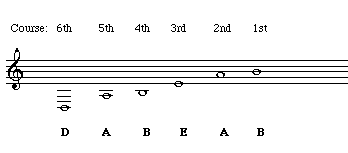
To notate a scale the tablature shows the six courses as the six horizontal lines below the normal stave. The numbers refer to the fret positions or fingerings for playing each note in turn; 0 indicates an open string.
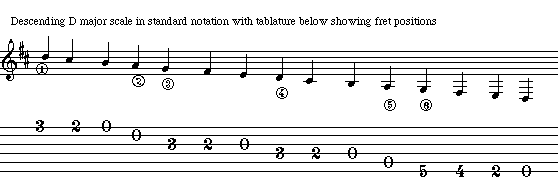
To show how the notation works in practice we reproduce two lines from an arrangement of Fado Menor em Re.
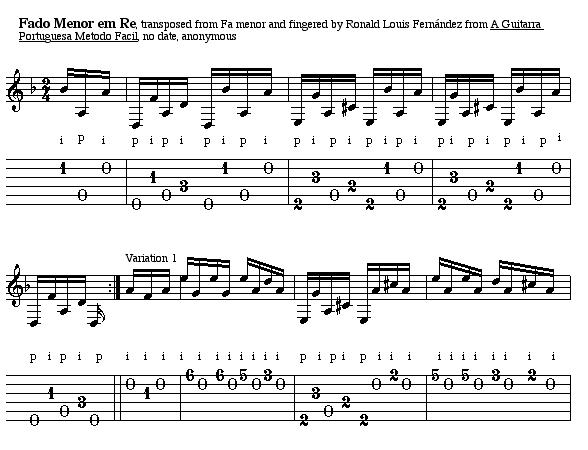
In the example below, we have scored the same running scale passage on two lines, the upper line is standard notation, where the pitch of each note can be read from the stave, and the lower line a TAB line for standard six-string guitar, where the pitch of each note is determined by knowing the pitch of each string (represented by the six lines of the TAB staff) and the placement of the finger along the fingerboard frets (given by the numbers on each line).
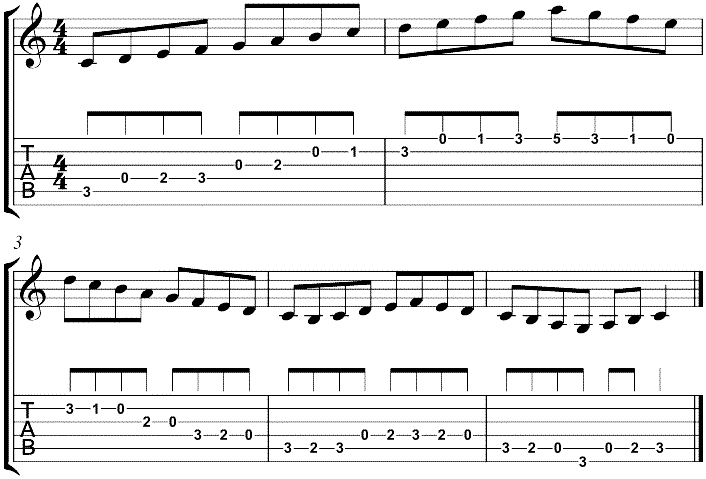
We list below all the standard chord symbols, names, component notes and chord formulae.
There is an excellent pop-up chord chart for guitar on the Chordfind.com web site.
| Chords | Names | Notes (bottom up) | Formula |
| Triads | |||
| C | C major | C, E, G | major 3rd, perfect fifth |
| Cmi | C minor | C, E flat, G | minor 3rd, perfect fifth |
| C+ | C augmented | C, E, G sharp | major 3rd, augmented fifth |
| Co | C diminished | C, E flat, G flat | minor 3rd, diminished fifth |
| Csus | C suspended fourth | C, F, G | suspended 4th, perfect fifth |
| Triads with Additional Notes | |||
| C6 | C major sixth | C, E, G, A | C plus major sixth |
| Cmi6 | C minor sixth | C, E flat, G, A | Cmi plus major sixth |
| C6/9 | C major six-nine | C, E, G, A, D | C plus major sixth and major ninth |
| Cmi6/9 | C minor six-nine | C, E flat, G, A, D | Cmi plus major sixth and major ninth |
| C2 | C major add two | C, D, E, G | C plus major second |
| Cmi2 | C minor add two | C, D, E flat, G | Cmin plus major second |
| Seventh Chords | |||
| Cma7 | C major seventh | C, E, G, B | C plus major seventh |
| Cmi7 | C minor seventh | C, E flat, G, B flat | Cmi plus minor seventh |
| C7 | C dominant seventh | C, E, G, B flat | C plus minor seventh |
| C+7 | C dominant seventh augmented fifth | C, E, G sharp, B flat | C+ plus minor seventh |
| Co7 | C diminish seventh | C, E flat, G flat, B double flat | Co plus diminished seventh |
| Cmi7(flat5) | C minor seventh (flat five) | C, E flat, G flat, B flat | Cmio plus minor seventh |
| Cmi(ma7) | C minor (major seventh) | C, E flat, G, B | Cmi plus major seventh |
| C7sus | C seventh suspended fourth | C, F, G, B flat | Csus plus minor seventh |
| Extended Chords - not all the lower extension notes need be voiced | |||
| Cma9 | C major ninth | C, E, G, B, D | Cma7 plus major ninth |
| Cmi9 | C minor ninth | C, E flat, G, B flat, D | Cmi7 plus major ninth |
| C9 | C dominant ninth | C, E, G, B flat, D | C7 plus major ninth |
| C+9 | C dominant ninth augmented fifth | C, E, G sharp, B flat, D | C+7 plus major ninth |
| C9(flat5) | C ninth flat fifth | C, E, G flat, B flat, D | C9 with diminished fifth |
| Cmi9(flat5) | C minor ninth (flat five) | C, E flat, G flat, B flat, D | Cmi9 with diminished five |
| C9sus | C ninth suspended fourth | C, F, G flat, B flat, D | C9 with suspended fourth |
| Cmi11 | C minor eleventh | C, E flat, G, B flat, D, F | Cmi9 plus eleventh |
| Cmi11(flat5) | C minor eleventh (flat five) | C, E flat, G flat, B flat, D, F | Cmi9(flat5) plus eleventh |
| Cma13 | C major thirteenth | C, E, G, B, D, F | Cma11 plus major thirteenth |
| C13 | C dominant thirteenth | C, E, G, B flat, D, F, A | C11 plus eleventh and major thirteenth |
| C13sus | C thirteenth suspended fourth | C, F, G, B flat, D, F, A | C13 with suspended fourth |
| Altered Chords | |||
| Cma9(flat5) | C major ninth (flat five) | C, E, G flat, B, D | Cma9 with a flat fifth |
| Cma13(sharp11) | C major thirteenth (sharp eleven) | C, E, G, B, D sharp, F | Cma13 with sharp eleventh |
| C7(flat9) | C dominant seventh (flat nine) | C, E, G, B flat, D flat | C7 plus minor ninth |
| C9(flat13/sharp11) | C dominant ninth (flat thirteen/sharp eleven) | C, E, G, B flat, D, F sharp, A flat | C9 plus sharp eleven and flat thirteenth |
| C13(sharp11/flat9) | C dominant thirteenth (sharp eleven/flat nine) | C, E, G, B flat, D flat, F sharp, A | C13 with sharp eleven and flat nine |
| C+7(sharp9) | C augmented seventh (sharp nine) | C, E, G sharp, B flat, D sharp | C+7 with sharp nine |
| Other Chords | |||
| C5 | C power chord | C G | C with no third |
| C5/2 | C5 add 2 | C, D, G | C with no third and a second |
| C/D | slash C over D | D, C, E, G | C plus D in bass |
| C D | polychord C over D | D, F sharp, A, C, E, G | C over D |
Players will come across other names, in some case chords misnamed, or not numbered in the 'conventional' way. There are variations in the naming of alterations; for example, m instead of mi for minor, b5 (i.e. flat 5) or #5 (i.e. sharp 5) may be written -5 or +5, respectively. The same terminology will be found for b9 (-9), b11 (-11), b13 (-13), #9 (+9), #11 (+11) and #13 (+13). We have collected some of the chords above in the chart of 'named' chords in lesson 17. We recommend that you study the chart above, rather than that in lesson 17, for the conventions we recommend.
The guitar's large range of special effects can be notated on standard stave notation and in tablature. We give a summary of the most common, each with a short description.
Arpeggios or spread chords, are notated in the same way as on a keyboard instrument, and are played 'up' the chord from the lowest note.
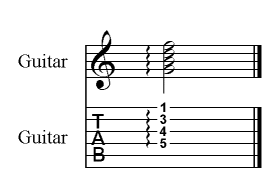
The pitch of a note can be changed while it sounds by sliding the finger on the fret before or after plucking or picking it so that its pitch alters down a fret or two if bending before sounding, up a fret or two if bending after sounding, or up and then back down again if bending after sounding. The sign is a curved arrow pointing up for an 'up' bend or down for a 'down' bend.
If the fret finger slides from one note up to a second note where the second note is not resounded, or the note is struck while the finger is sliding, these are called slides rather than bends. The difference is that bends occur during notes, while slides happen between notes. Slides are shown by a line lying between two notes and the letters sl. placed above the line.
If the fret finger touches the string lightly and the string is then plucked 'belllike' high natural harmonics are produced. A similar result is produced when with a string, fretted in the normal way, is lightly touched over a fret by one of the plucking hand fingers while a second finger plucks the string. These are called artificial harmonics. A harmonic is shown with a diamond notehead and, in tablature, both fret positions are shown on the same line (corresponding to the two fingers on the same string).
Muted playing, where the fret hand lies on the strings and the plucking hand strikes the string is shown by using the percussion symbol, an x for the note head, while the palm mute effect, where the plucking hand touches the strings just ahead of the bridge to dampen the sound, is shown by writting P.M. over the staff or tablature line.
Three or four oblique lines written across the tail of a note is called tremolo. The note is played repeatedly as quickly as possible. If, instead, the fret finger is rolled back and forth rapidly the effect is called vibrato. It is marked with a wavy horizontal above the stave which shows the duration of the effect.
Alisdair MacRae Birch, a New York based guitar teacher, points out that because a guitar has only six strings and a guitarist five fingers, some chords have to be adapted, in particular by leaving out internal voicings or notes. For example, a major 9th chord might be played by using a major 7th chord with the root raised by a whole tone to produce the 9th. The root is missing from the chord, and this modification is called 'rootless voicing'.
So
Major 7th Voiced : 7-3-5-1
Major 9th Voiced : 7-3-5-9
Why can the guitarist get away with missing out the root? The root of a chord can be implied by other notes, mainly the third and seventh. The notes that are used are called 'guide notes' (or 'guide tones', 'target notes', 'goal notes'). The third is important because it gives you the tonality of the chord, major or minor, while the seventh could be a major seventh or a minor seventh (as in a dominant 7th chord) and that distinction is important too. So the root is implied rather than played. Many guitar players are habit-bound playing root-position chords and think it necessary to play every note in every chord. In fact, to make the art of chord melody playing more musical, the main consideration must be the melody. If the addition of the third and seventh of the chord is sufficient and rhythmically appropriate there is no need for the root.
In the common ii-»V-»I progression, the seventh of each chord moves chromatically to the third of the next chord. These notes and the way they move from seventh to third make the progression clear.
The term 'rootless voicing' is also used when the root of a chord is left out in a keyboard part because it is being played on another instrument, for example a bass guitar, or on the organ pedal board. In a jazz combo the pianist never plays the root note of the chord otherwise he would be duplicating the bass players job of laying down the root harmonies. Jazz keyboard players like Bill Evans frequently use rootless voicings because by leaving out the root in the voicing, the chordal harmony is given a more ambiguous flavour opening the door to more interesting harmonic possibilities.
The fact that notes can be implied and need not be played is one of the basic features of the jazz written by Duke Ellington, one of the greatest of jazz composers. By opening up the texture and thereby increasing the harmonic ambiguity, Ellington had invented the device to open up a completely new and highly influential style of jazz music - he had found the "Divine Simplicity".
References: